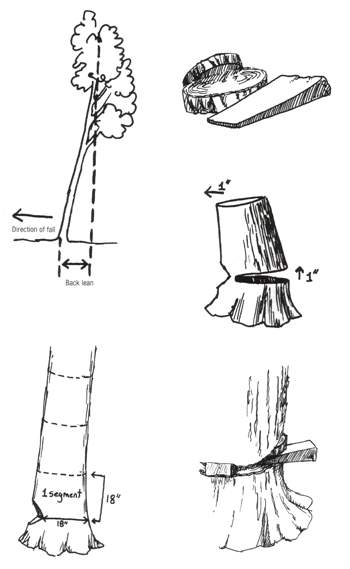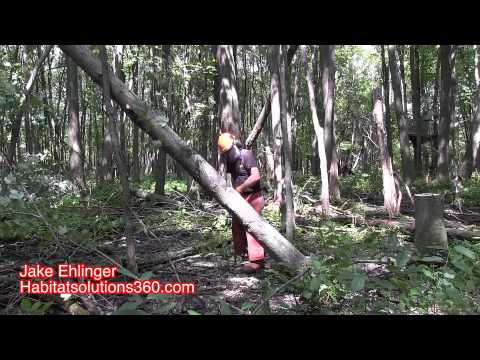To cut a tree leaning on another tree, you must first assess the direction of the lean and plan a strategic cutting angle accordingly. When dealing with a tree leaning against another, it is essential to approach the situation with caution and proper planning.
Cutting a tree leaning on another tree requires a careful analysis of the direction of the lean. By assessing the angle at which the tree is leaning, you can determine the best cutting angle to safely remove the leaning tree without causing damage to the adjacent tree.

Credit: chainsawacademy.husqvarna.com
We will explore the step-by-step process of cutting a tree leaning on another tree, ensuring a successful and safe removal.
Assess The Situation
Assessing the situation is the first crucial step in safely cutting a tree leaning on another tree. Proper evaluation helps to identify potential risks and the best approach to tackle the task. Let’s break down the assessment process into two key aspects.
Check The Lean And Obstacles
Before you proceed with cutting the leaning tree, it’s essential to assess its lean and identify any obstacles that could impede its fall. Start by studying the angle at which the tree is leaning and determine the direction in which it would naturally fall. Look for any branches, other trees, or structures that could obstruct its path.
Evaluate The Stability Of The Leaning Tree
Next, evaluate the stability of the leaning tree. Inspect the trunk for signs of rot, cracks, or weakness. Assess the root system to gauge the tree’s stability. Look for any signs of decay or damage that could compromise its integrity. Understanding the condition of the leaning tree is vital in devising a safe cutting strategy.
Gather The Right Tools
When it comes to cutting down a tree that is leaning on another tree, gathering the right tools is essential for a successful removal. Having the appropriate equipment will not only make the job easier but also ensure your safety throughout the process. In this section, we will discuss two key tools you will need: a chainsaw or handsaw and safety equipment.
Chainsaw Or Handsaw
A chainsaw or handsaw is the primary tool you’ll need to cut down a tree leaning against another tree. The choice between them depends on the size of the tree and the level of precision required for the job.
- Chainsaw: A chainsaw is recommended for larger trees or situations where the tree is firmly entangled with the leaning tree. It provides the power and speed necessary to cut through thick trunks efficiently. Before using a chainsaw, make sure you are familiar with its operation, maintain a sharp chain, and wear protective gear such as safety goggles and ear protection.
- Handsaw: On the other hand, if the tree is relatively smaller and easy to manage, a handsaw can be a suitable option. A handsaw allows for greater control and precision while cutting, making it ideal for situations where the space is limited or the tree’s branches are close to other structures. Remember to choose a handsaw with sharp teeth and a comfortable grip for smoother cutting.
Safety Equipment
Aside from the cutting tool, it is crucial to prioritize your safety by wearing the appropriate equipment. Protect yourself from potential hazards with the following safety gear:
- Safety goggles: Shield your eyes from flying debris, wood chips, and sawdust.
- Ear protection: Reduce the risk of hearing damage caused by the loud noise of the chainsaw.
- Gloves: Keep your hands safe from cuts, blisters, and splinters.
- Hard hat: Ensure your head is protected from falling branches or other objects.
- Steel-toed boots: Choose sturdy footwear to safeguard your feet against any potential injuries.
- Protective clothing: Wear long sleeves, long pants, and a thick jacket to shield your body from cuts, scratches, and other damages.
Gathering the right tools, whether it be a chainsaw or handsaw, as well as the necessary safety equipment, is crucial before attempting to cut down a tree leaning on another tree. By equipping yourself with the appropriate tools and protective gear, you can ensure a safe and efficient tree removal process.
How to Cut a Tree Leaning on Another Tree : Step by Step Guide
Plan Your Cuts
When it comes to cutting a tree that’s leaning on another tree, proper planning is crucial. In this step-by-step guide, we’ll walk you through the process of planning your cuts to ensure a safe and effective tree removal. Follow these steps to smoothly execute the task of cutting a tree leaning on another tree:
Identify The Direction Of The Fall
The first thing you need to do is assess the direction in which the tree is likely to fall. This will help you determine the safest cutting points and ensure that the falling tree does not cause any damage. To identify the direction of the fall:
- Stand a few feet away from the tree and examine its angle of lean. Is it leaning towards a specific direction?
- Look for any signs of stress or weakness in the tree, such as broken branches or cracks. These indicators can give you insight into the potential direction of the fall.
- Observe the surrounding area for obstacles that could potentially obstruct the fall. Are there any structures, fences, or power lines that need to be avoided?
By carefully assessing these factors, you can determine the direction in which the tree is most likely to fall and plan your cuts accordingly.
Determine The Escape Route
Once you have established the direction of the fall, it is equally important to determine your escape route. This ensures that you have a clear path to safety once the tree starts to fall. To determine the escape route:
- Identify a clear path that is away from the falling tree and any potential hazards.
- Make sure the escape route is wide enough for you to quickly move away from the falling tree.
- Consider the possibility of the tree bouncing or rolling after it hits the ground. Plan your escape route to avoid any potential dangers in this scenario as well.
Remember, your safety is of utmost importance, so take the time to carefully plan your escape route before making any cuts.
By following these steps and planning your cuts in advance, you can effectively remove a tree leaning on another tree without any risk of injury or damage.

Credit: northernwoodlands.org
Make The Proper Cuts
When cutting a tree that is leaning on another tree, it is crucial to make the proper cuts to ensure the safety of yourself and others around. Making the right cuts will help to control the direction in which the tree falls, minimizing the risk of accidents and damage. Let’s look at the steps involved in making the proper cuts when dealing with a tree leaning on another tree.
Cut A Notch On The Side Of The Lean
To begin, cut a notch on the side of the tree where it is leaning. This notch will help guide the tree’s direction as it falls, allowing you to control the angle of its descent. Ensure that the notch is facing in the desired direction for the tree to fall.
Create A Horizontal Cut
Next, create a horizontal cut on the opposite side of the notch. This cut should be made at a level slightly above the bottom of the notch and should extend into the tree until the two cuts meet. This horizontal cut will weaken the tree, making it easier for the tree to fall in the intended direction.
Release The Tension
Once the notch and horizontal cut are in place, carefully release the tension by making a final cut on the opposite side of the tree, allowing it to finally fall in the intended direction. Take your time and ensure that all safety precautions are in place before releasing the tree to prevent any accidents or mishaps.
Remove The Fallen Tree
Once you have successfully cut down a tree leaning on another tree, the next step is to remove the fallen tree. This is an important task to ensure the safety of the area and to clear the way for further work. Follow these steps to remove the fallen tree:
Cut The Tree Into Manageable Sections
The first step in removing the fallen tree is to cut it into smaller, more manageable sections. This will make it easier to handle and transport the tree. Here’s how you can do it:
- Start by identifying the natural breaks or weak points in the tree trunk.
- Using a chainsaw, make a horizontal cut at the base of the tree, just above the ground.
- Next, make a vertical cut from the top down, along the length of the tree, following the natural breaks or weak points.
- Continue making these horizontal and vertical cuts until you have completely separated the fallen tree into smaller sections.
Clear The Area
Once you have cut the fallen tree into manageable sections, it’s time to clear the area. This step is crucial to ensure the safety of the surroundings. Follow these guidelines:
- Remove any debris, branches, or twigs that may be in the way.
- Inspect the area for any other potential hazards, such as loose branches or unstable ground, and address them accordingly.
- Make sure there is enough space to work comfortably and safely.
- If needed, use an appropriate tool, such as a hand saw or an ax, to further trim the sections of the fallen tree for easier handling and transport.
- Dispose of the cut tree sections or use them for firewood, mulch, or other purposes.
By following these steps, you can efficiently remove a fallen tree that was leaning on another tree. Remember to prioritize safety throughout the process and take necessary precautions to prevent accidents or injuries.

Credit: www.reddit.com
Frequently Asked Questions On How To Cut A Tree Leaning On Another Tree
How Do You Remove A Tree Leaning On Another Tree?
To remove a tree leaning on another tree, follow these steps: 1. Assess the situation and determine the angle of the lean. 2. Use ropes and pulleys to support and guide the tree as it is cut down. 3. Start by removing branches and limbs from the leaning tree.
4. Cut the tree trunk from the base, beginning with the side away from the lean. 5. Gradually cut the trunk, allowing the ropes to guide the tree’s fall away from the supporting tree.
How Do You Cut A Leaning Tree?
To cut a leaning tree, determine its fall direction, clear the area, and plan your route. Make an undercut on the side facing the fall, then make a back cut. Be cautious and consider consulting a professional for safety.
How Far Can A Tree Lean Before It Falls?
A tree can lean quite a bit before it falls. The exact distance will vary depending on factors such as the tree species, soil conditions, and prevailing winds. However, if a tree leans more than its center of gravity can handle, it will eventually topple over.
How Do You Get A Widowmaker Down?
To take down a Widowmaker, you need to focus on her positioning. Use heroes like Winston, Genji, or D. Va to dive on her and disrupt her sniping. Coordinate with your team to flank her and apply pressure. Communication and teamwork are crucial for countering Widowmaker effectively.
Conclusion
Mastering the art of cutting a tree leaning on another tree requires caution, skill, and the right approach. By following the steps outlined in this guide, you can safely and efficiently remove the leaning tree without causing damage or risking safety.
Remember to prioritize safety and precision throughout the process.

